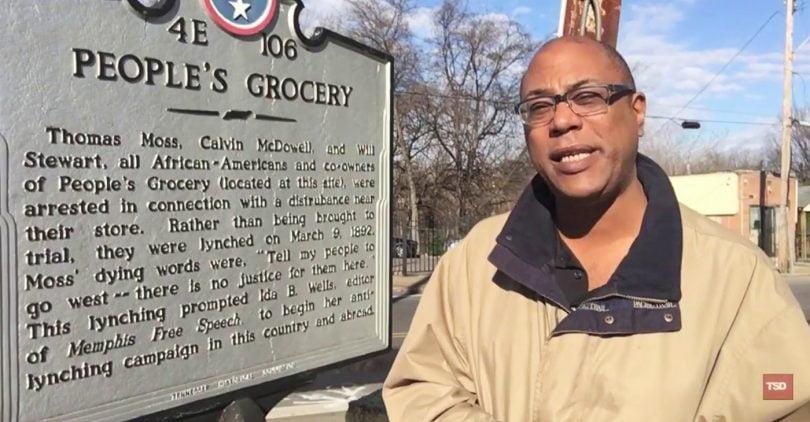New TSD video series tells forgotten history of Memphis
by Lee Eric Smith 02/18/2019
Over the course of February (and maybe beyond), we’ll bring you short video clips of historic places you drive or walk by every day – places that have profound historic implications that go overlooked all the time. We published the first one, “The People’s Grocery,” on Feb. 5.
As we here at The New Tri-State Defender pause to reflect on African-American History Month, my own journey has brought me to make these bold recommendations to the Shelby County School Board and interim Superintendent Joris Ray:
There should be a class called “The History of Memphis.”
This class should be mandatory.
This class should have ZERO textbooks and should be taught on foot, out in the city.
This came into stark relief for me as I began working on our new TSD video series “History: Hidden in Plain Sight.” Over the course of February (and maybe beyond), we’ll bring you short video clips of historic places you drive or walk by every day – places that have profound historic implications that go overlooked all the time. We published the first one, “The People’s Grocery,” on Feb. 5.
For me, this journey literally started in the TSD offices. Like many newspapers, we have replicas of early editions of our paper on display around the office. No surprise, there are some with stories about Dr. Martin Luther King; I saw one story about black G.I.s returning from Vietnam. It was what happened on March 30, 1968 that caught my attention.
Most of history recognizes that day for the march that Dr. Martin Luther King Jr. attempted down Main Street, in support of the 1968 sanitation strike. When protesters got rowdy, King was quickly spirited away, to avoid controversy. But that’s not the story I saw on the wall at the TSD.
Just a few blocks away from King’s attempted march, at the intersection of Wellington and Linden, was a bar/diner called “The Big M.” Located at what’s now known as Martin Luther King Avenue and Danny Thomas Boulevard, The Big M was where many of Memphis’ white-collar working class came to wind down.
But on this day – the same day of King’s failed march – it was a nightmare.
Unannounced and apparently unprovoked, Memphis police stormed The Big M with nightsticks in hand – kicking butt and not worrying with names. The TSD offices were so close that a badly beaten man collapsed on the steps of the newspaper.
The Big M is long gone now, replaced by the grassy lawn of Pentecostal COGIC, which overlooks another historic landmark, the Universal Life Insurance Building. Things change.
But that brings me back to my bold recommendations: “The History of Memphis” should be mandatory for all SCS students. And when students enter that class, they should be exiting a tour bus.
Too often, history is simply a subject in school, just another thing to memorize so students can (hopefully) pass a test. And we spend so much time and energy teaching kids about ancient events in faraway places, yet so little teaching about what happened down the street or across town.
Which is why the class needs to be taught on foot. On the printed page – or on historical markers, for that matter, the stories are just words. But when you actually GO and SEE these historical places for yourself, the history just comes alive. You learn about the lesser-known people and events that led to the major events. You begin to see yourself in the story. And you start to understand WHY things are the way they are.
That’s what we’re trying to do with this series.
Do you know what the curriculum was at The University of West Tennessee? Did you even know there WAS a University of West Tennessee?
Or imagine a dispute among children playing a game escalating into a lynch mob that killed one of your closest friends and two others – essentially for being successful businessmen. How far would you go for justice for your friend? And what if your pursuit of justice put your own life at risk?
If those scenarios don’t seem familiar to you, stay tuned – those are the topics of the first two clips in our series. No spoilers here – you’ll have to watch. Visit www.tri-statedefender.com or check out www.youtube.com/tristatedefender for those stories and the others we’ll be telling in the coming weeks.
Working on this project has introduced me to a fascinating paradox. Other than historical markers, there’s nothing left to acknowledge the existence of People’s Grocery or The University of West Tennessee or so many other historic sites around town.
These historic markers were erected to ensure that these places and events are not forgotten. And yet they go largely ignored, blending into the background of our daily commute, along with the “We Buy Houses” signs and billboards from lawyers with catchy jingles. It’s right there; we’re just not paying attention.
If we do this right, you won’t see these markers the same way again – and maybe you’ll get curious enough to do some research of your own. You might even find yourself slowing down just a tad, to observe the history you’ve been zipping past all along.
History – hidden in plain sight.
(Lee Eric Smith is an NNPA award-winning columnist, journalist and author. Follow him on Twitter: @L3ESmith or on Facebook: @iamleeericsmith )


